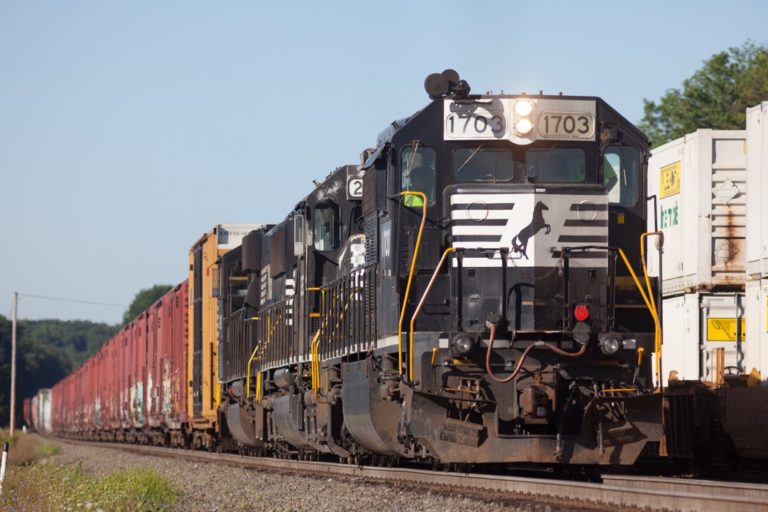“Man…” I thought, “I’m not getting out of bed for this!”
John Z had just burst into the room explaining that a train was stopped outside The Station Inn, with a rare SD45-2 being towed behind the newer, more typical Norfolk Southern locomotives that pass by here daily.
I reasoned that breakfast was more important. I was still paying a price for the past two days’ festivities. Besides, while the SD45-2’s are rare, it’s not all that atypical for them to travel back-and-forth between northern New Jersey (where they spend most of their time today) and Norfolk Southern’s Conway Yard for routine maintenance. I’ve seen them before, and figured I’d see them again – and besides, it’s not like these things are leading the train, right?
Only once before, to my recollection, did an SD45-2 lead a train over the Pittsburgh Division. In 2015, Norfolk Southern decided to paint #1700 into the same Erie-Lackawanna livery that it wore when it was built in November, 1972. On October 18, 2015, Norfolk Southern’s company photographer, Casey Thomason, arranged for the 1700 to lead the Conway-Allentown 10N mixed freight:

OK, so that WAS pretty awesome. That day, PittsburghMike and I were able to photograph the 10N at a couple of locations on the Conemaugh Line northeast of Pittsburgh.
Years ago, it was a bit easier to find and photograph the SD45-2 fleet in Pennsylvania. Originally built for long-haul trains between New York and Chicago, the thirteen E-L SD45-2’s were built with a distinctive 5000-gallon fuel tank, so that the units could make the entire trip without refueling. Also, these units were most powerful of the mainline diesels of their time – packing 3600 horsepower with a 20-cylinder 645E3 diesel engine. In 1976, Erie-Lackawanna became part of the Conrail merger, and the thirteen-unit fleet eventually wore Conrail’s signature blue.
By the 1990’s – when I made my first trips to the Altoona & Cresson (Pennsylvania) areas – the SD45-2’s were often found in helper service, pushing heavy coal, ore, and freight trains over the summit of the Alleghenies. By this time, very few 20-cylinder engines were still in service, some having been converted to a more-common 16-cylinder type. One summer day in 1997, I photographed a gaggle of them moving around the Cresson engine terminal:

Of course, CSXT and Norfolk Southern purchased and dismembered Conrail in 1999, dividing rail lines, freight cars, and locomotives between the two companies. Today, three of the SD45-2’s survive on CSX, and five on Norfolk Southern. Many of them continue working for “today’s” Conrail – the Shared Assets Area in Northern New Jersey. As noted earlier, the NS units in the fleet occasionally make a round-trip to Conway Yard for routine maintenance.
—
Breakfast was tasty – blueberry pancakes – but not as good as my favorites, the Sausage Gravy biscuit, or even better… the Pork Roll sandwich. As I finished the last of my coffee, I could see through the window that this train was still stopped at the signals at “MO”. A few guys excitedly ran inside to announce that the power was turned… and the SD45-2 was leading!
[box]This eastbound train, later revealed to be the same Conway-Allentown 10N, had experienced mechanical problems with the original leading locomotive. While I munched my pancakes, the crew “spun” the power by turning it around (reports differ as to where – they could have “wyed” the power consist at Cresson or at the “loop” at Gallitzin), placing the NS 1703 into the lead position.[/box]
I hopped into the Pathfinder with a few of the guys, and motored quickly down to the Railfan Viewing Platform in Cresson. Everyone’s pretty excited to see this unfold:

I swapped to my long telephoto lens and chatted with a father-and-son team that was videoing the event. (It’s always great to see the hobby passed down to the younger generation!) After a few minutes, a double-stack train overtook the 10N on track 2, and a bit later, the 10N started east:

We decided that we needed to try to get to AR Tower. With some creative driving, we barely made it. I made quick use of a hole in the fence to capture the 1703 starting downgrade, past the disused tower at AR:

We watched and listened as the three “ponies” started down the steep grade. Nick egged us on to try to get to Benny. We thought that to be crazy, but a good idea nonetheless. I was grateful for the 4×4 and high ground clearance of the Pathfinder as we went down the cemetery access road, and ambled our way back to the trail. [Apologies here to the same father-and-son video team seen earlier, as we enveloped them in road dust, not realizing they’d be there!] We could hear the dynamic brakes whine on the three locomotives as we lept out of the car and ran like crazy for the overlook. Panting and out-of-breath, we made it to the “spot” as a westbound started its way uphill on Track Three. The 10N slowly made its way down Track One, putting on an excellent show for us!

With memory cards full, and emotions running high, we decided we’d return to The Station Inn and get on with the rest of our day – which included seeing CSX’s “Johnstown Jet” local make a rare Sunday move, and seeing a few trains on the NS main in Johnstown as well. All in all, a great day – and I didn’t have to skip breakfast, either.
